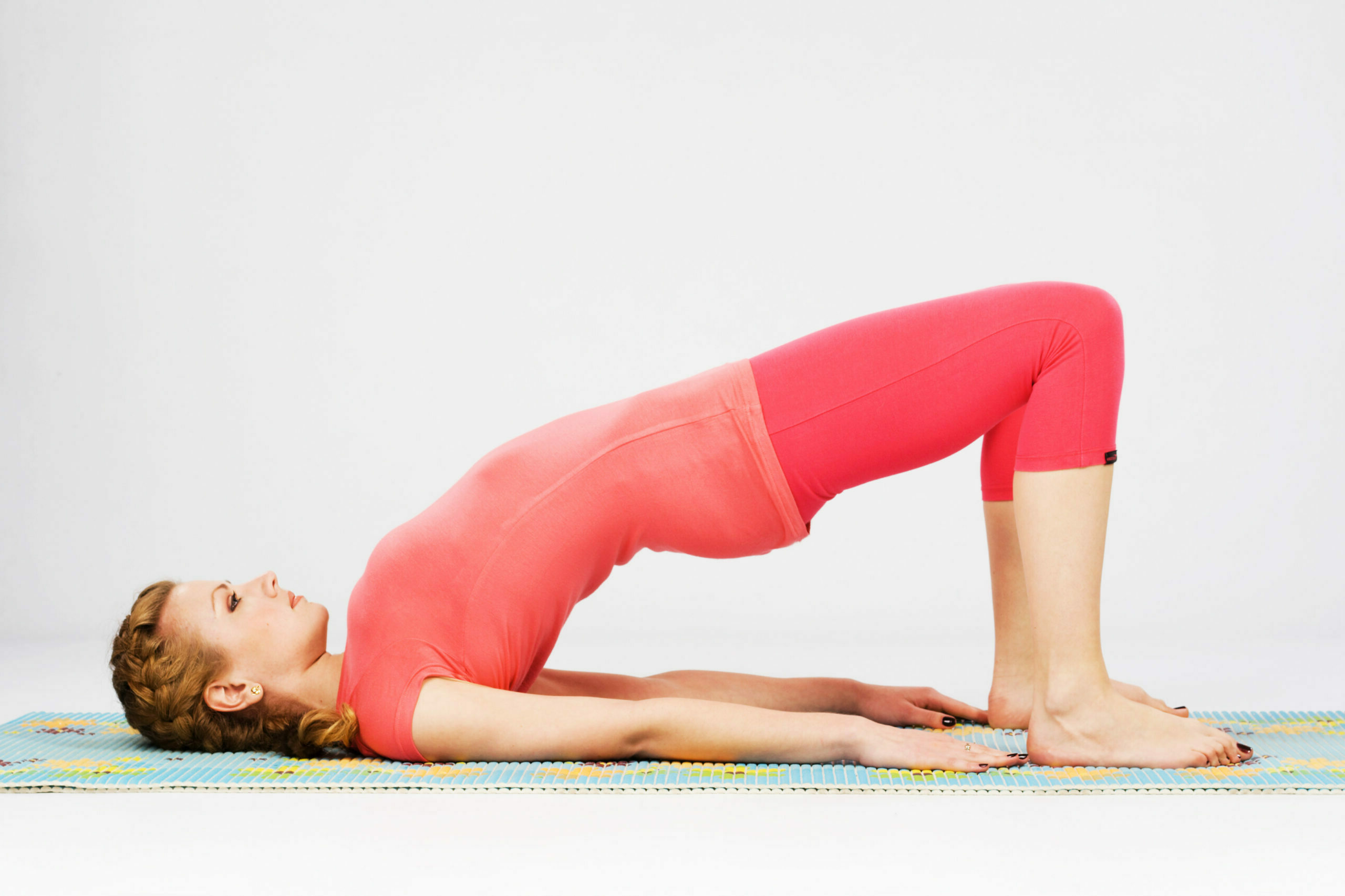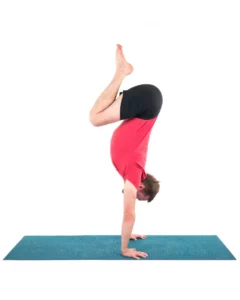Change Up Your Yoga Practice: 4 Bridge Pose Variations to Target Different Muscle Groups

Variety is the spice of life. When it comes to your yoga practice, variety and variability help keep things fresh and exciting, challenge your tissues in new and unique ways, and keep you literally and figuratively on your mat. Variability really offers benefits for your body, mind, and soul.
Bridge Pose (Setu Bandhasana) is an oft-visited posture in asana practice that is very often taught in the same way. Typically, it’s practiced with the feet hips-distance apart and aligned directly underneath the knees, with the chest and hips elevated and the fingers clasped behind the back.
And while the traditional alignment is great, there are also so many other ways to practice this versatile posture to target different muscle groups or challenge your body and mind in new and unique ways.
How to Spice Up Your Bridge Pose
For these variations, you will need a yoga block (or thick book), a yoga strap (or belt), and a blanket (or socks).
1. Glute-Strengthening Bridge Pose Variation

The gluteus maximus (the largest and most superficial muscle of the buttocks) is our primary hip extensor. We use this muscle to lift into a traditional Bridge Pose alignment, but after the initial ”lift-off,” we don’t particularly harness its strength.
This variation of Bridge will help to activate your gluteus maximus as you hold.
How to Practice Glute-Strengthening
- Lie down on your back and bend your knees to plant your feet on the floor roughly hip-distance apart. You can keep your feet as they are or externally rotate your thighs so that your heels turn in and your toes turn out to target the aspects of the gluteus maximus that create external rotation in the hips.
- Slide your feet toward your seat until you feel like your ankles align roughly underneath your knees.
- Root down firmly into your feet and extend your tailbone toward your toes.
- Keep extending your tailbone as you press down equally into your shoulders and feet, and slowly lift your hips up off the floor by rolling up one vertebra at a time.
- Continue to curl up one bone at a time until you reach your shoulder blades. Keep your scapulae rooted firmly to the ground and hollow your belly toward your spine to maintain the curve of your back body.
- Energetically draw your tailbone toward your knees into a posterior pelvic tilt as you hold for a few deep breaths.
2. Abductor-Strengthening Bridge Pose

The abductors are a group of muscles that run along the hips’ outer edges and help draw the legs into abduction (moving away from the midline).
While these muscles are great stabilizers of the outer hips, they don’t often get all the love they deserve in Bridge Pose. This variation aims to address them directly.
How to Practice Abductor-Strengthening
- Make a loop in your strap and step through the loop with both legs.
- Lie down on your back, bend your knees, and place your feet on the floor roughly hips-distance apart.
- Slide your strap up to your thighs just above your knees and tighten it so that when you press your legs out against the strap, the strap will hold your legs in place at roughly hips-distance.
- Root down firmly into your shoulders and your feet, and lift your hips and chest up from the floor.
- Press your legs out against your strap and feel the resistance that the strap creates against your legs.
- Continue to press against your strap with your hips held high for a few deep breaths.
3. Adductor-Strengthening Bridge Pose Variation

The antagonists to the abductors are the adductors. This is a group of muscles that runs down the inner thighs and works to adduct the legs (draw them toward or across the midline of the body).
While the entire hip girdle works in a traditional Bridge Pose, this variation emphasizes the strengthening aspect of the adductor muscles.
How to Practice Adductor-Strengthening Bridge Pose
- Lie down on your back with a block nearby.
- Bend your knees and plant your feet on the floor, roughly hips-distance apart, with your knees stacked roughly above your ankles. You can keep your feet as they are or internally rotate your thighs by turning your toes and heels out.
- Place your block between your thighs. Choose the thickness setting of your block—thin or medium—that feels appropriate for your particular body dimensions.
- Firmly squeeze your thighs into your block and maintain this squeezing action.
- Root down equally into your feet and shoulders to lift your hips off the floor.
- Continue to squeeze against your block as you hold your hips high for a few deep breaths.
4. Hamstring-Strengthening Bridge Pose

The hamstrings often get a lot of love in yoga when it comes to stretching. However, in their strengthening capacity, they tend to be neglected. As a synergist to the gluteus maximus, they work to extend the hip. They are also powerful knee flexors. So Bridge Pose is the perfect place to strongly work the hamstrings since your hips are extended and your knees are flexed.
This variation will make your hamstrings burn (in a good way!).
How to Practice Hamstring-Strengthening
- Fold your mat in half, and place your mat on a slippery surface, such as a wood floor. Lie on your back on your mat so that your torso is on the mat and your feet are on the floor.
- Place a folded blanket just off your mat at the “foot” end. Alternatively, put socks on your feet and place your feet off the bottom of your mat on the slippery surface.
- Plant your feet roughly hips-distance apart on your blanket or the floor (if you’re wearing socks).
- Flex your ankles, lift your toes, and ground your heels firmly on the floor.
- Without movement, energetically slide your heels toward your seat to feel your hamstrings activate.
- Keep your toes lifted and your heels energetically hugging toward you as you root down into your shoulders and heels and lift your hips off the floor.
- Maintain the height of your hips and inhale to slide your blanket or your socks forward about six to eight inches so your heels move farther away from your seat.
- As you exhale, slide your heels back in closely toward you.
- Continue to slide your heels forward and back with your hips and chest lifted for a few deep breaths.
How to Reap the Benefits of Variability in Yoga Practice

There are infinite ways that you can practice any given pose. Depending on your intention (physically or spiritually), you can add variety and variability to your practice in so many different ways.
Play with these variations of Bridge Pose, or make up your own! Maybe target a specific muscle group or flow organically in whatever way your body craves. Perhaps explore how different shapes affect your breath or how prana moves through you when you alter your body’s position.
There is no right or wrong way to practice any posture. In fact, practicing any posture in the same way over and over again may be more detrimental than practicing a pose in a new way every time you step on your mat. So, add variety to your practice. And watch how it blossoms and transforms.
Also, read...
Is Knee Hyperextension Bad? 4 Triangle Pose Hacks for Hyperextended Knees
Finding Freedom Through Practice: A Book Review of Practicing the Yoga Sutras by Carroll Ann Friedmann
Yoga Pose Primer: Malasana (Garland Pose) – Strengthen Your Pelvic Foundation
Related courses
Keys to Effective Yoga Teaching: The Most Important Takeaways from a Life of Teaching
Yoga and Detoxification: Tips for Stimulating Lymphatic Health
Free Download! Sacred Teaching, Simple Truths: Five Decades of Yoga Wisdom

Leah Sugerman is a yoga teacher, writer, and passionate world traveler. An eternally grateful student, she has trained in countless schools and traditions of the practice. She teaches a fusion of the styles she has studied with a strong emphasis on breath, alignment, and anatomical integrity. Leah teaches workshops, retreats, and trainings, both internationally and online. For more information, visit www.leahsugerman.com.
